Our view at Stack - Simplify growth with an all-in-one platform. Powerful marketing, sales, and support automation. Integrated CMS. Scalable software. Crafted for customer experience.
Creating a project timeline where everyone involved knows what they‘re working on (and when it’s due) can help ward off project creep and nail those important deadlines.
![→ Access Now: 16 Timeline & Flowchart Templates [Free Tool]](https://no-cache.hubspot.com/cta/default/53/6aa60787-a844-4b56-ab23-2b2aa079e7fc.png)
It’s essential for keeping projects — and the people completing them — on track.
As a caretaker, I have project timelines running invisibly in my mind at all times, and most families would be a hot mess without someone in the managerial role.
The smoothest way for everyone to succeed despite the chaos is to have a hand at the wheel and an eye on the timeline. It all sounds very TVA, and frankly, that’s how metal it is to parents.
To help you make sure that your next professional project stays on schedule, I’ll cover the project management basics of how to set up a project timeline, the best templates to use, and a handful of examples to inspire your future scheduling.
And yes — you can absolutely apply these skills and resources to life admin, too.
Table of Contents
- Project Timeline Template
- What is a project timeline?
- Why create a project timeline?
- How to Create a Project Timeline
- Project Timeline Examples
What is a project timeline?
Simply put, a project timeline is a visual display that tracks the completion of various steps in a project over time.
It is a meta-view of all tasks involved in an outcome, enabling a project manager to better direct the people who are responsible for the steps involved — as well as report the project’s status to stakeholders.
After assigning tasks, it’d be wonderful if they got done on time and with no issues, arriving on or before the agreed-upon delivery date, right?
But we all know how quickly a timeline can fall apart as higher priorities pop up and deadlines slip past without much progress.
And I’ve seen first hand that projects can fail for many reasons up the chain of command as well, including a lack of support from leadership, unforeseen budget cuts, or overpromising outcomes.
Less than ideal outcomes are still fairly common even when you do invest in project management.
While 59% of formally managed projects are completed on time — which is an excellent statistic that skilled and intentional project managers can be proud of — this still means that 41% do not.
Why create a project timeline?
Time management is one of the top skills employers look for in candidates up and down the org chart. Missed deadlines and rushed projects can set entire teams — and sometimes entire companies — behind schedule.
I don’t want to be that person, and I know you don’t, either. But there will always be people on teams that need support to stick the landing on expectations that affect the larger project.
A well-built project timeline is much more than a nice visual to reassure the stakeholders, and here are just a few reasons why you should create one. It’s a living, changing, and functional process overview that can:
- Bring leadership and structure to a project.
- Outline what is being delivered and by when.
- Share who is responsible for each task and set expectations for the scope, quality, and delivery of work.
- Show how the project outcome contributes to company goals.
- Decrease risk by accounting for any changes to the project scope, budget, deliverables, or deadlines.
Ultimately, a project timeline makes it both easier and more efficient to manage a project — particularly when you choose a timeline structure that is well-fit to the project’s scope.
This is where a project timeline template can help you move forward.
Project Timeline Template
The ideal timeline brings direction to a project, yet is easily adaptable when changes arise.
Without the right project timeline template, organizing a project can be a lot of time-consuming manual work — not to mention the formatting chaos once multiple people get their hands on it. Woof.
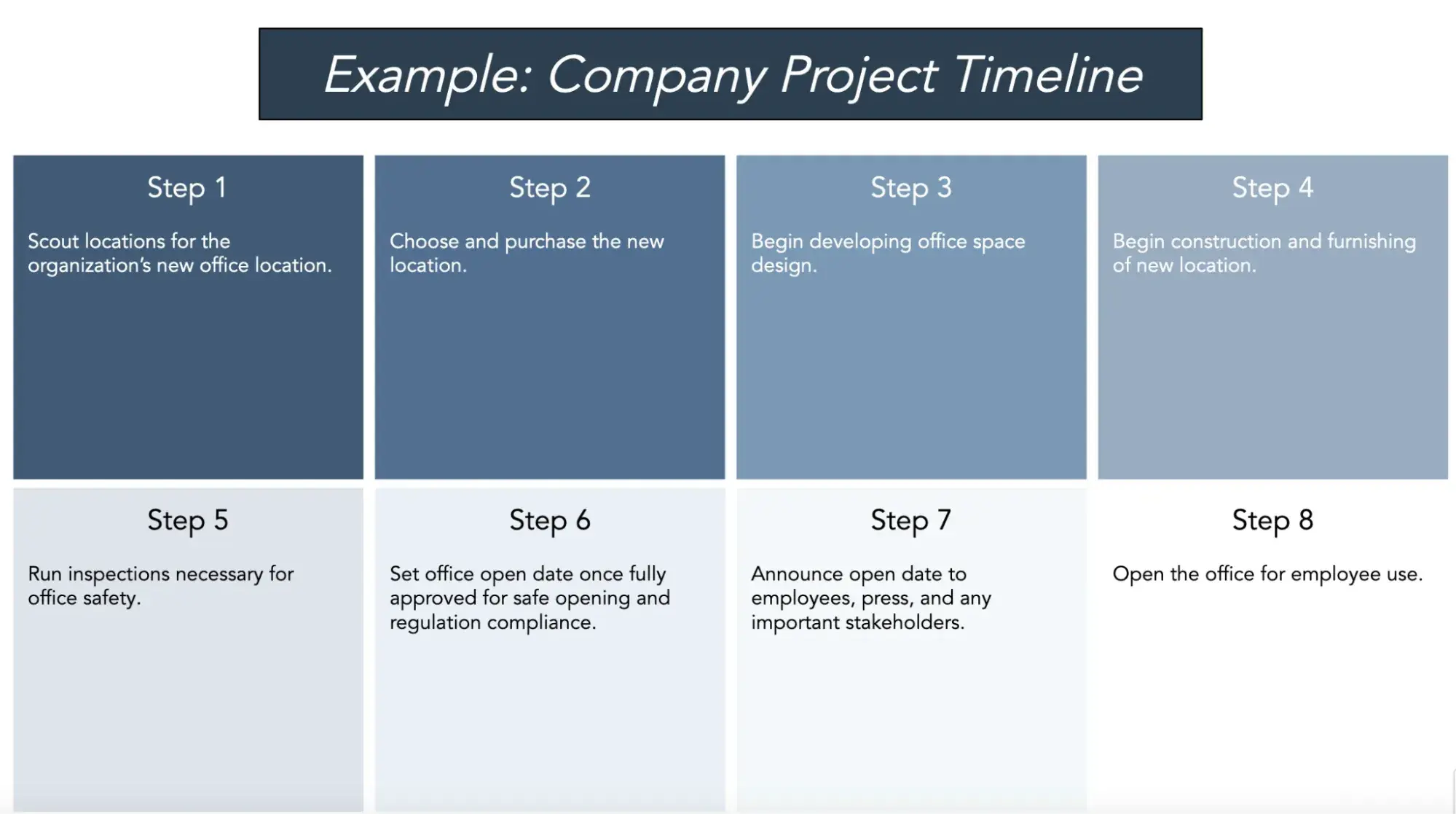
Download this Template for Free
I like to create a project timeline for any process that relies on a schedule (almost everything these days), like onboarding employees, handling a crisis, or planning social media campaigns.
All you need to know is how to outline the steps of a project and the tasks required to complete each phase. Let’s do it!
How to Create a Project Timeline
Crafting the perfect project timeline takes strategy, organizational skills, and a whole lot of collaboration. You need buy-in from supporters and clear directives for everyone involved.
To get started, I recommended following this step-by-step guide to set up a structured timeline — no matter your job, industry, or management level.
1. Write a project brief.
A project brief communicates how you will approach a project. It includes details on the goals, deliverables, timeline, tasks, process, people involved, and resources needed to take a project from start to finish.
Asana outlined the steps to create a simple, yet effective, project brief. You can use this free project plan template to outline the project’s goals, roles, and responsibilities. You can then plan your schedules, deliverables, budget, and more.
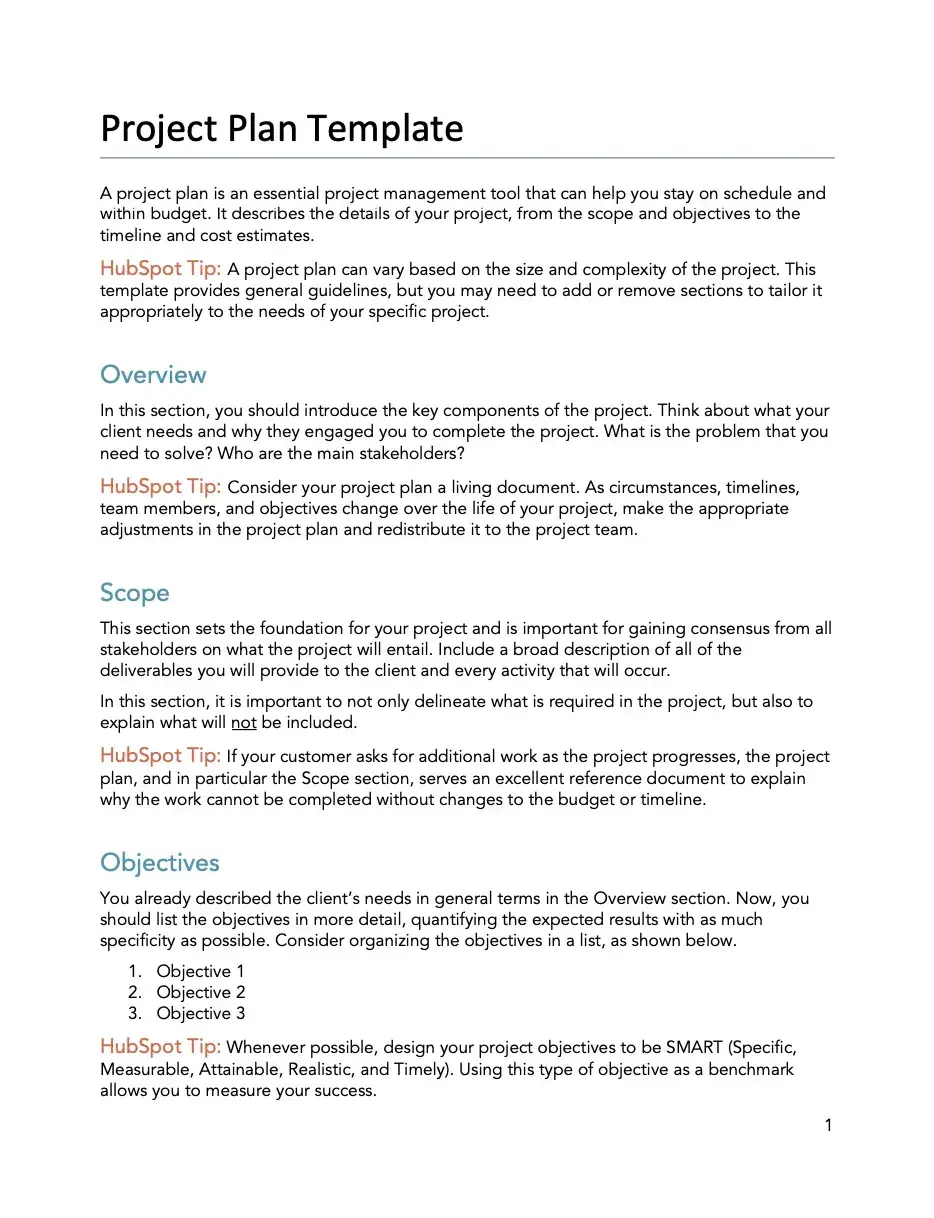
Image Source
Pro tip: While this resource is a great starting point for any planning process, if you need a more comprehensive overview that includes key messaging and distribution processes, a creative brief may be the right fit for your project.
2. List all tasks and action items.
Every task involved in achieving a project’s objectives needs to go into the project timeline. After creating the brief, make a list of these tasks. You can start with large tasks and break them down into smaller to-dos.
Let‘s say you’re responsible for creating a marketing video to launch your company’s newest product. Your list may include the following:
- Establish project leads from each department.
- Set project budget.
- Find a video production company.
- Layout the video storyboard.
- Choose main features for video.
- Write video script.
- Capture video content.
- Add in sound and background music.
- Add animations and graphics.
- Edit video.
- Write announcement copy.
- Craft marketing campaign.
- Create clips for social sharing.
- Get video and marketing assets approved.
Once I have the major milestones down, I then like to break down each task into smaller pieces. For example, choosing a video production company can involve:
- Research video production companies.
- Curate a list of production companies.
- Get quotes from each production company.
- Compare quotes and narrow down options.
- Meet with the selected companies.
- Choose a production company.
- Finalize the contract.
3. Connect dependencies.
In a project, certain tasks can‘t be started until another is complete. These tasks are called dependencies. For example, a video can’t be filmed until the storyboard is finalized. And the storyboard can’t be finalized until the video theme is chosen.
Mapping out dependencies helps you solidify the order of each task and decide who is responsible for what. Everyone will know what part of the project they’re working on, which tasks must be completed before their own, and who to contact for the deliverables they need.
Here’s a look at how dependencies can play out in a project timeline.
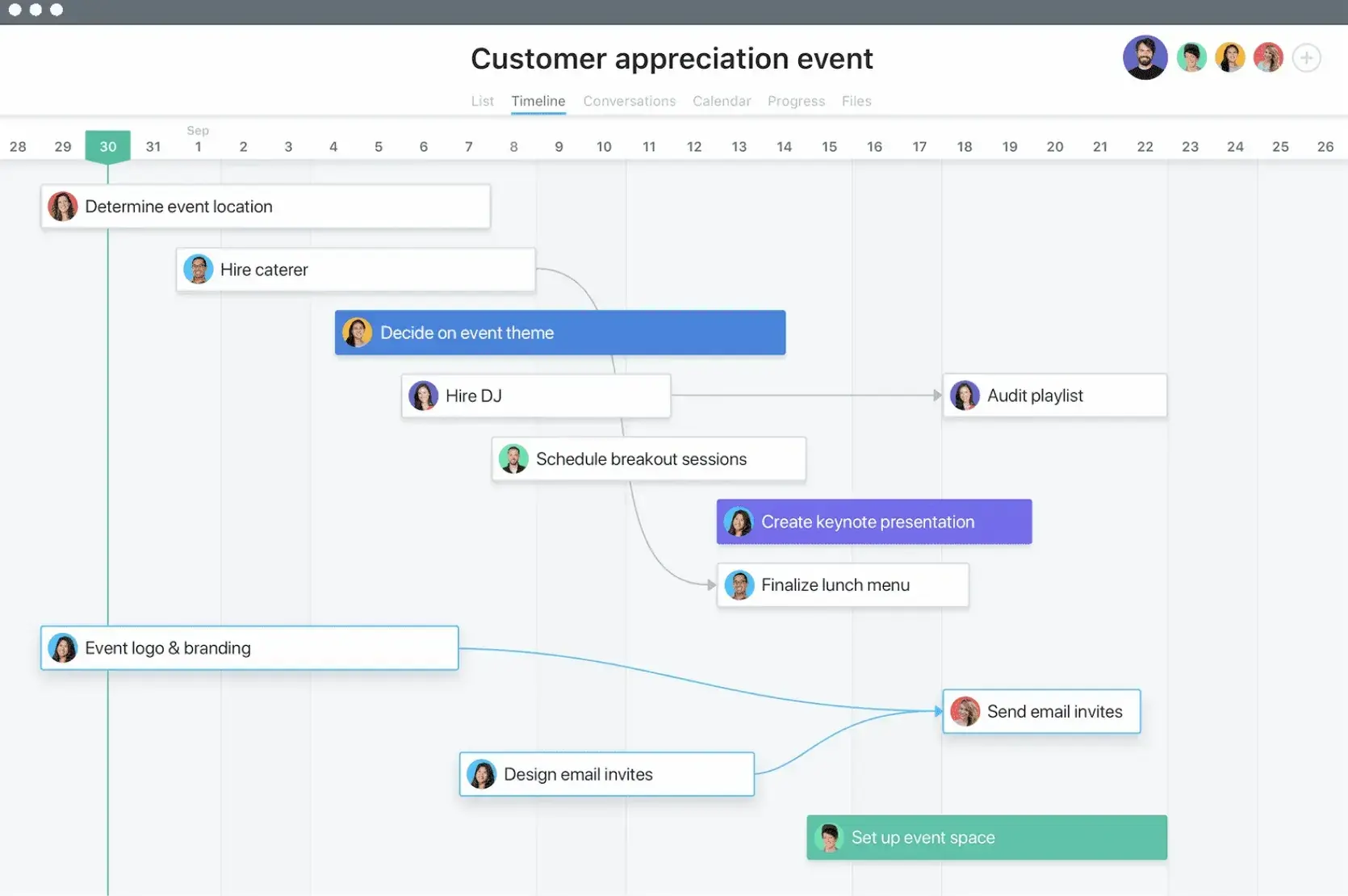
Image Source
In the example, you can see that hiring a caterer has to happen before finalizing the lunch menu. But other tasks, like finding a DJ and deciding on an event theme, can happen at the same time. So, as you map out each task, you’ll have to see which steps can overlap and which need to wait for others.
4. Estimate the time it will take to complete each task.
Once you figure out the sequence of tasks, you need to figure out how much time each will take. Without direct experience and/or knowing your team members, this can be the trickiest part, but try not to break your brains on it. Just estimate as closely as you can so you’re not losing too much time trying to tell the future.
Part of this mental math includes considering the other projects and priorities your team has going on. A designer may be able to come up with a rough draft of video animations in one week, but if they’re wrapping up another project, they may not be able to start on yours for another two weeks.
Being mindful of your team‘s time will make it easier to put together a reasonable, reliable timeline. It’ll be easier to create the project roadmap and understand the project’s overall time frame once you put together all of these estimations.
5. Create the project timeline.
Build your timeline by organizing your tasks from the first to the final step.
Make any necessary adjustments to the task times, add milestones, and solidify the deadline. If your team works with a timeline maker or project management software, organize the timeline and tasks so it’s ready to share after the project kickoff meeting.
Pro tip: You can save time during this step by using one of the project timeline templates below. It’s simple to customize each and avoid the extra work of creating your own from scratch.
6. Share the timeline with the project team.
Whew! Your timeline is complete. Next, you get to share it with stakeholders. This includes everyone who is involved in the project.
You‘ve already listed these people in your brief (during step one), so it’s time to share your project’s path forward with them.
It’s a good idea to hold a project kickoff meeting for both stakeholders and individual contributors so everyone starts on the same page.
You can communicate the project goals, deliverables, roles, and deadlines — without going into an overwhelming amount of detail.
From there, you‘ll want to schedule time with the project’s immediate contributors to chat specifics and answer any questions before the work begins.
Need help visualizing the entire project? I recommend including a timeline graphic like the one below to give everyone a sense of the overall time frame. You can add or remove steps, depending on the complexity of your project.
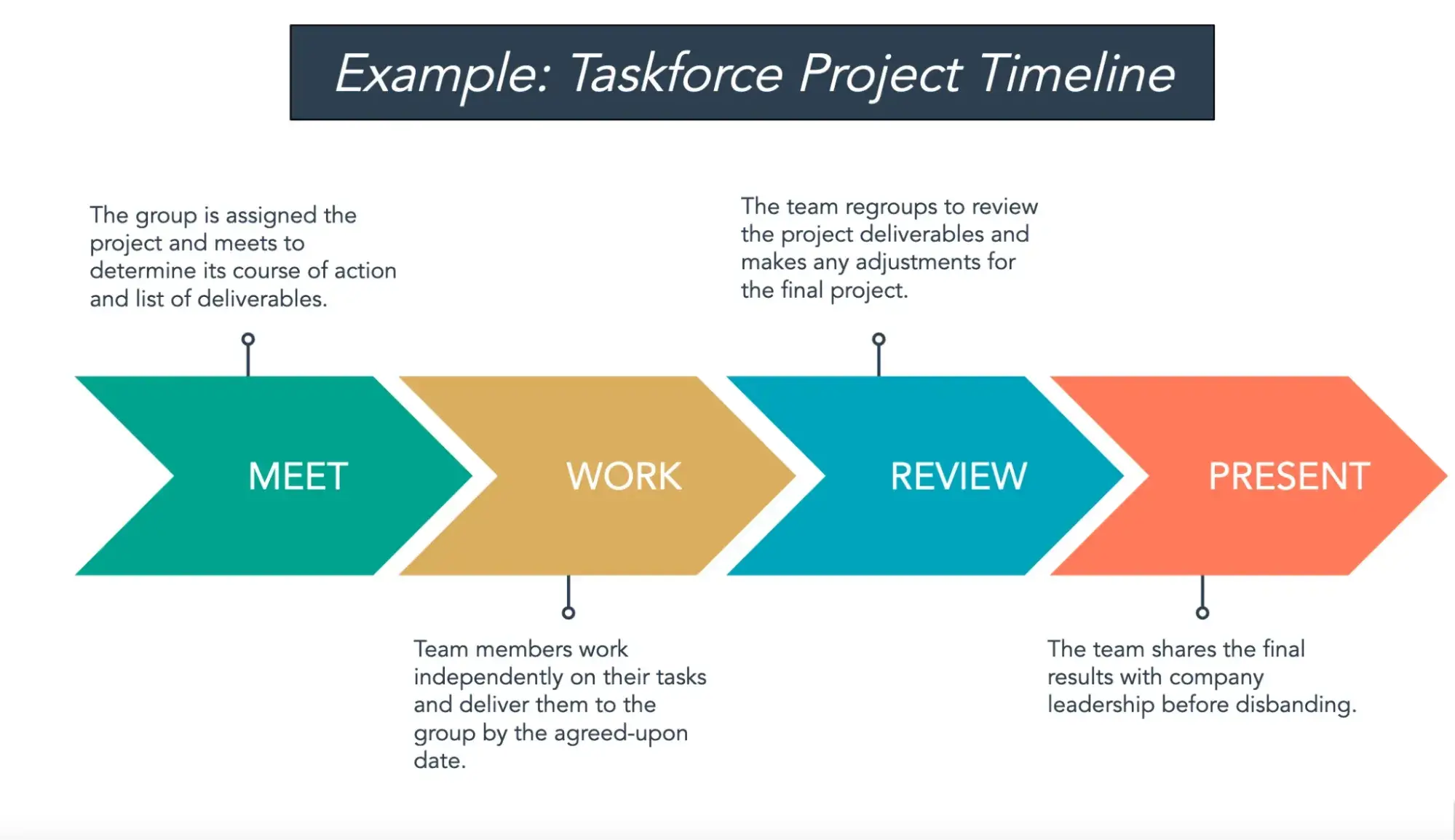
Download this Template for Free
7. Adapt as you go.
Remember how just over half of projects are finished on time? Roadblocks and setbacks are inevitable in every project. So, if your team runs into a delay, you’ll have to understand the impact and adjust the timeline if necessary.
While it‘s possible to make up for delays without changing the final deadline, it’s your job as the project owner to update stakeholders on the project‘s progress.
Reporting a minor issue like a coworker being out sick for a few days isn’t always necessary for higher-ups.
But if it’s a major roadblock that requires an extreme adjustment to the timeline — like a core contributor leaving the team — you have to communicate a new timeline to stakeholders.
Change is part of every process, so don‘t panic if you have to adjust your timeline.
It’s better to be transparent about the scope of work and timeline than to keep people in the dark, hoping it’ll work out. The earlier you adjust to change, the more time you have to pivot — and the easier it will be to get back on track.
Project Timeline Examples
Visualizing a project makes it simple to understand what needs to happen from start to finish.
Whether you need a template for a product launch or campaign meeting, these well-designed project timeline templates I’ve gathered up to show you are perfect for your next planning session.
Employee Onboarding Timeline
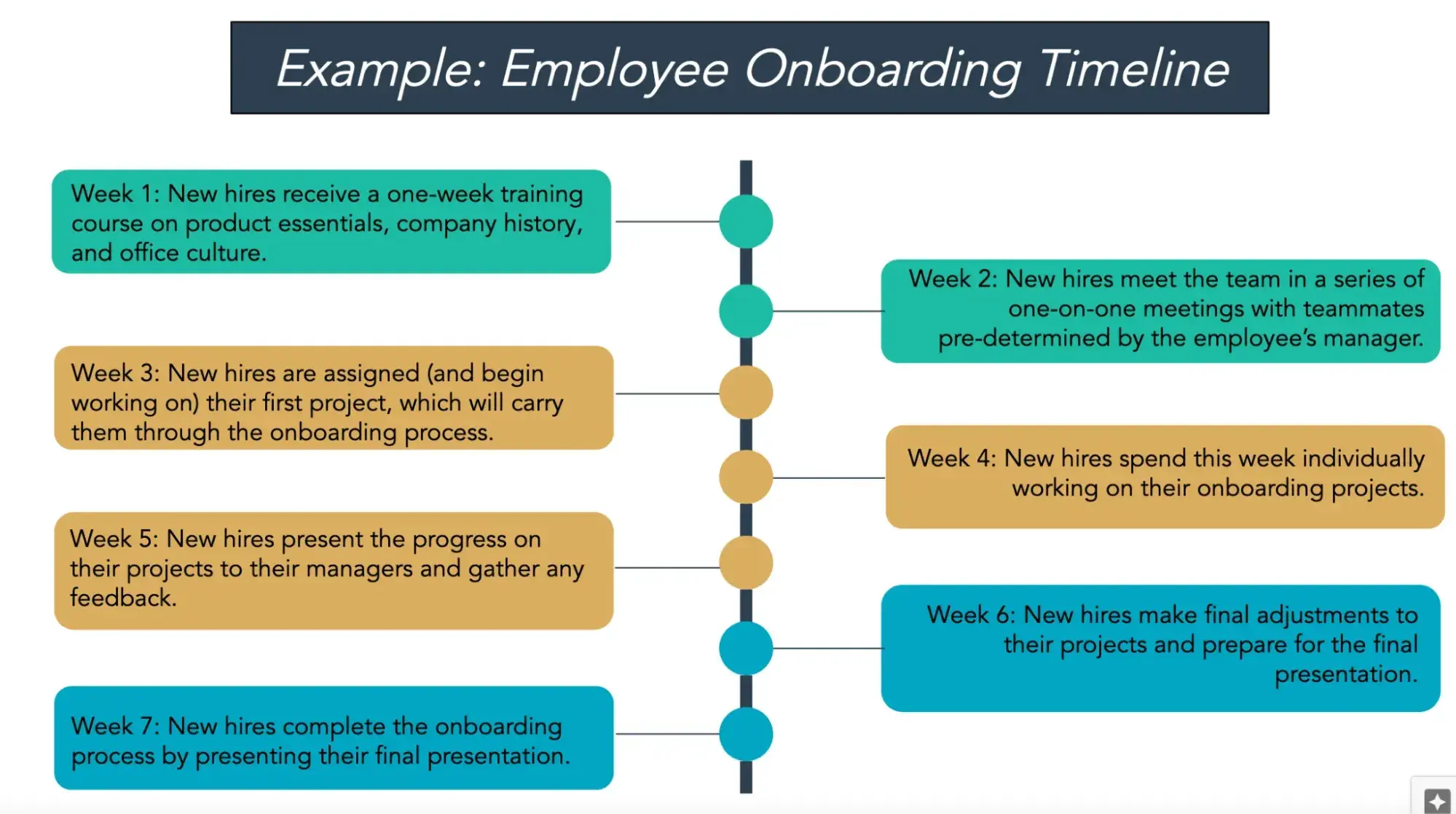
Download this Template for Free
This vertical timeline offers a way to plan and track your new hire’s journey as they ramp up. As you get to know them and find where they need support, you can make adjustments to the timeline to more accurately chart their progress, prepare the resources they will need, etc.
Pro tip: Onboarding is important and deserves deep planning. Many professionals get their first real introduction to a company via the onboarding process, so you want it to go smoothly with all possible supports ready to throw in the ring.
You’ll keep your team whole and happier for longer if they know they are being led with competency from the very start.
Product Launch Timeline
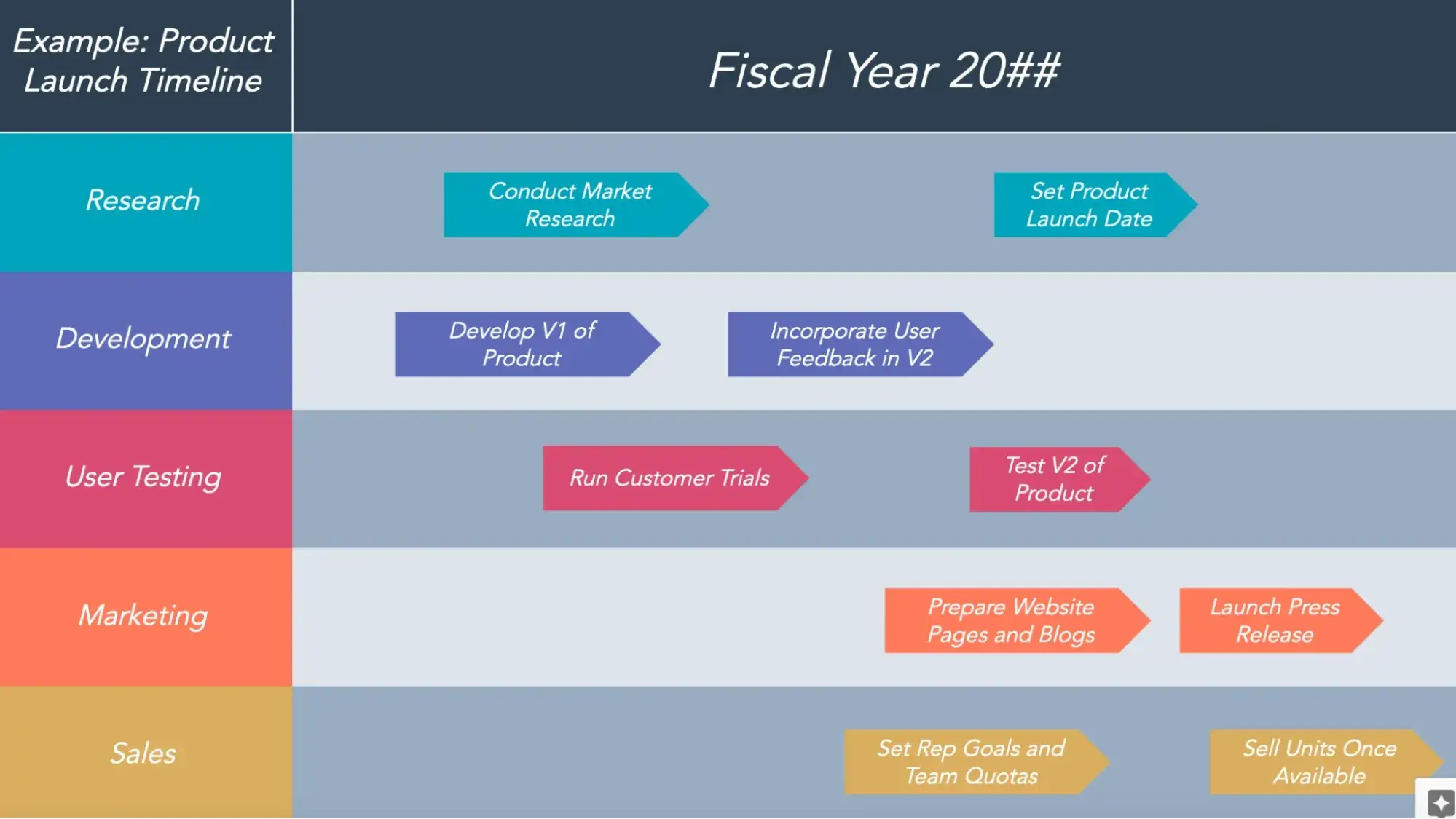
Download this Template for Free
This horizontal product launch timeline can help you see the overlap of processes as time moves forward like a river. This gives team members an idea of when their cohort will need to lean in as the project moves along.
Best for: This is an excellent communication vehicle for oversight purposes. This isn’t getting bogged down with details — it’s a roadmap for stakeholders to understand the overall flow, their places in it, and how they will contribute.
Crisis Response Project Timeline
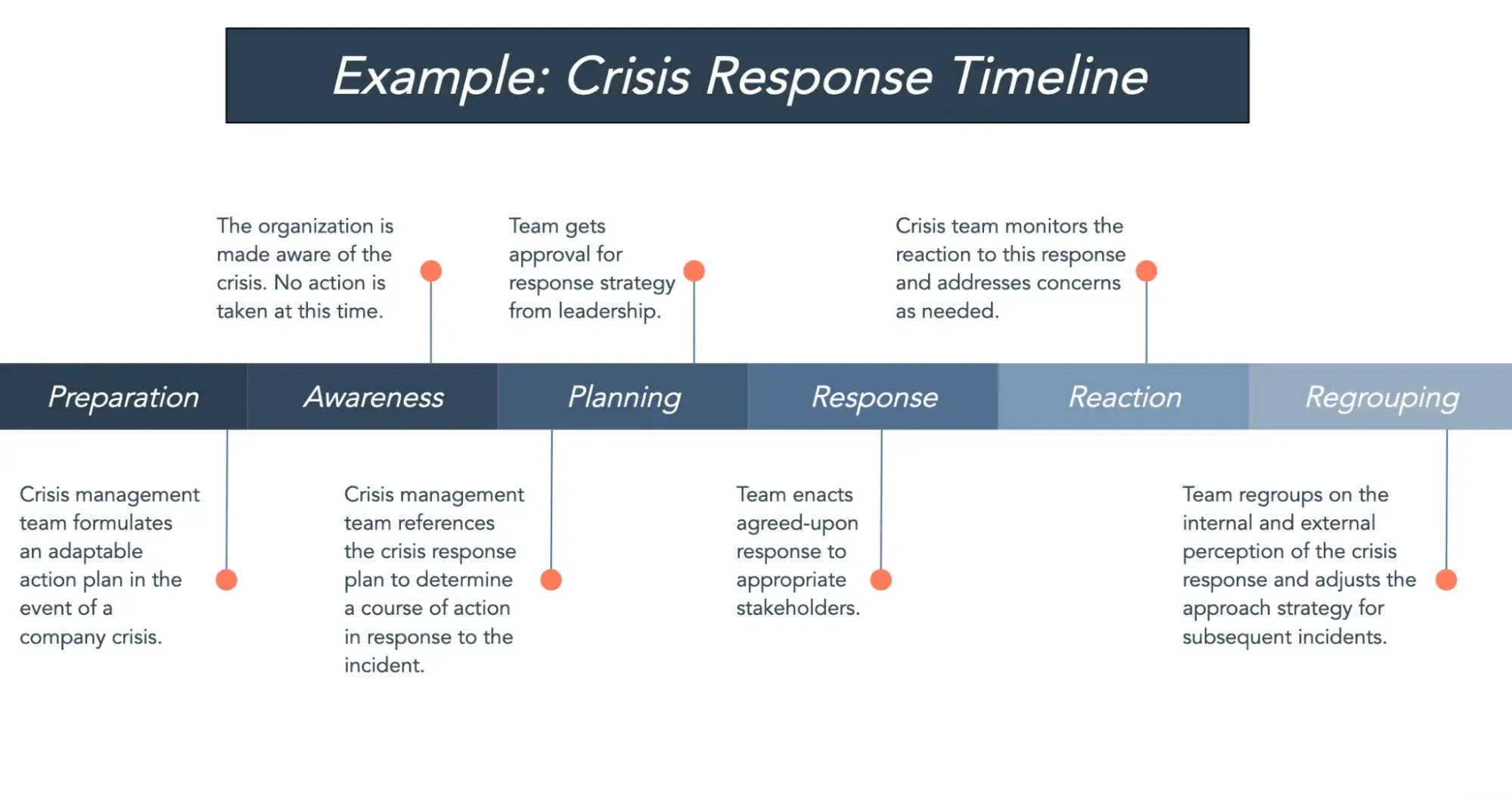
Download this Template for Free
It’s okay to hope for the best in any management role, but it’s often your job to plan for the worst. The best way to handle a problem is to anticipate it and communicate in advance of it, which this crisis response timeline does beautifully.
What I like: The very important Regrouping step at the end. The best project managers I’ve ever worked with make sure that the last steps include learning from the crisis outcomes to improve the plan for when — not if — it happens again.
Historical Timeline
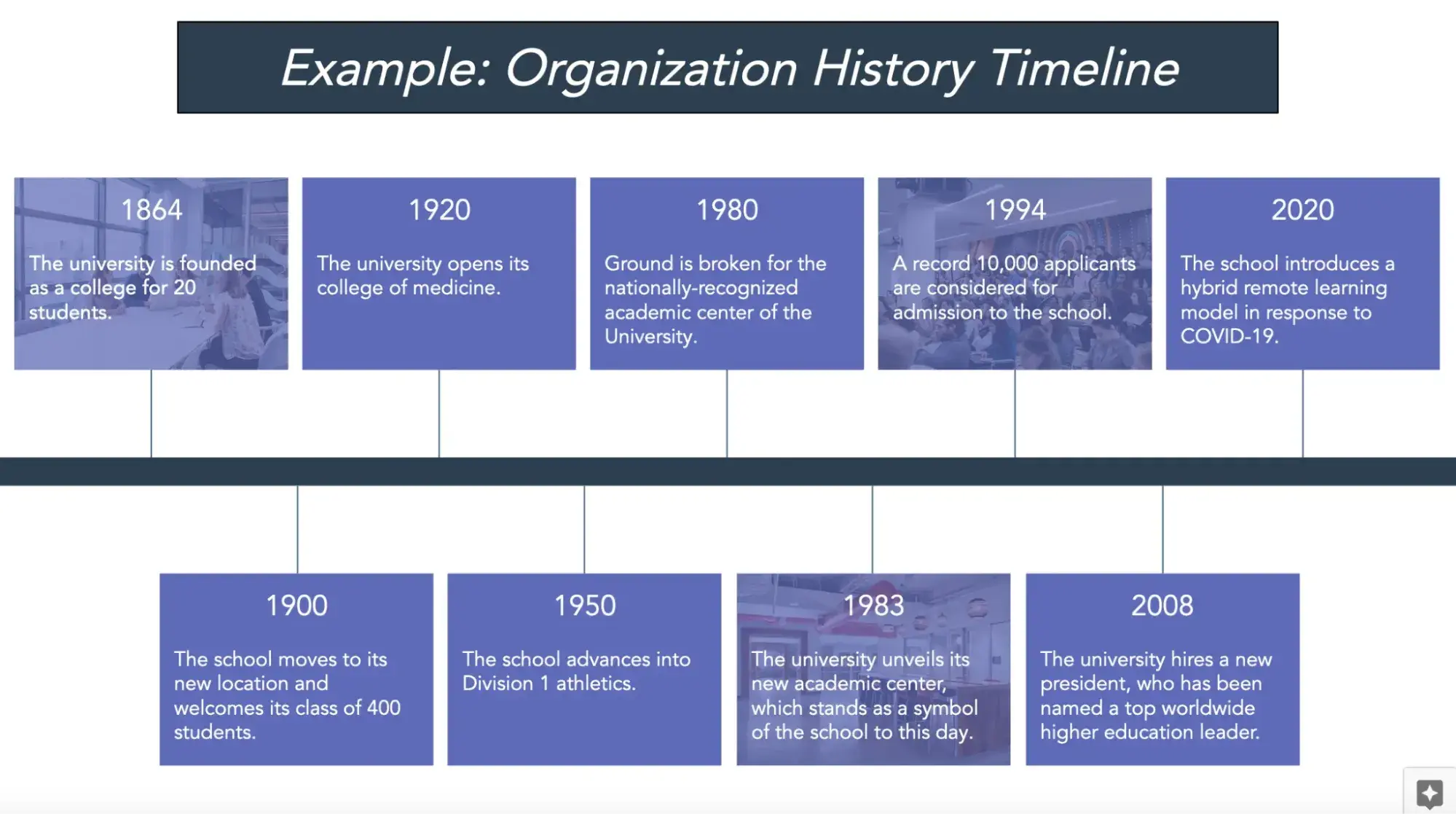
Download this Template for Free
Historical timelines like these are familiar from school projects, but as professionals, they are excellent to have on hand for your company for a variety of reasons. You may have company representatives to educate, visitors to impress, or potential investors who want to see proof of growth and development over time.
Best for: Educational purposes.
Task Project Timeline
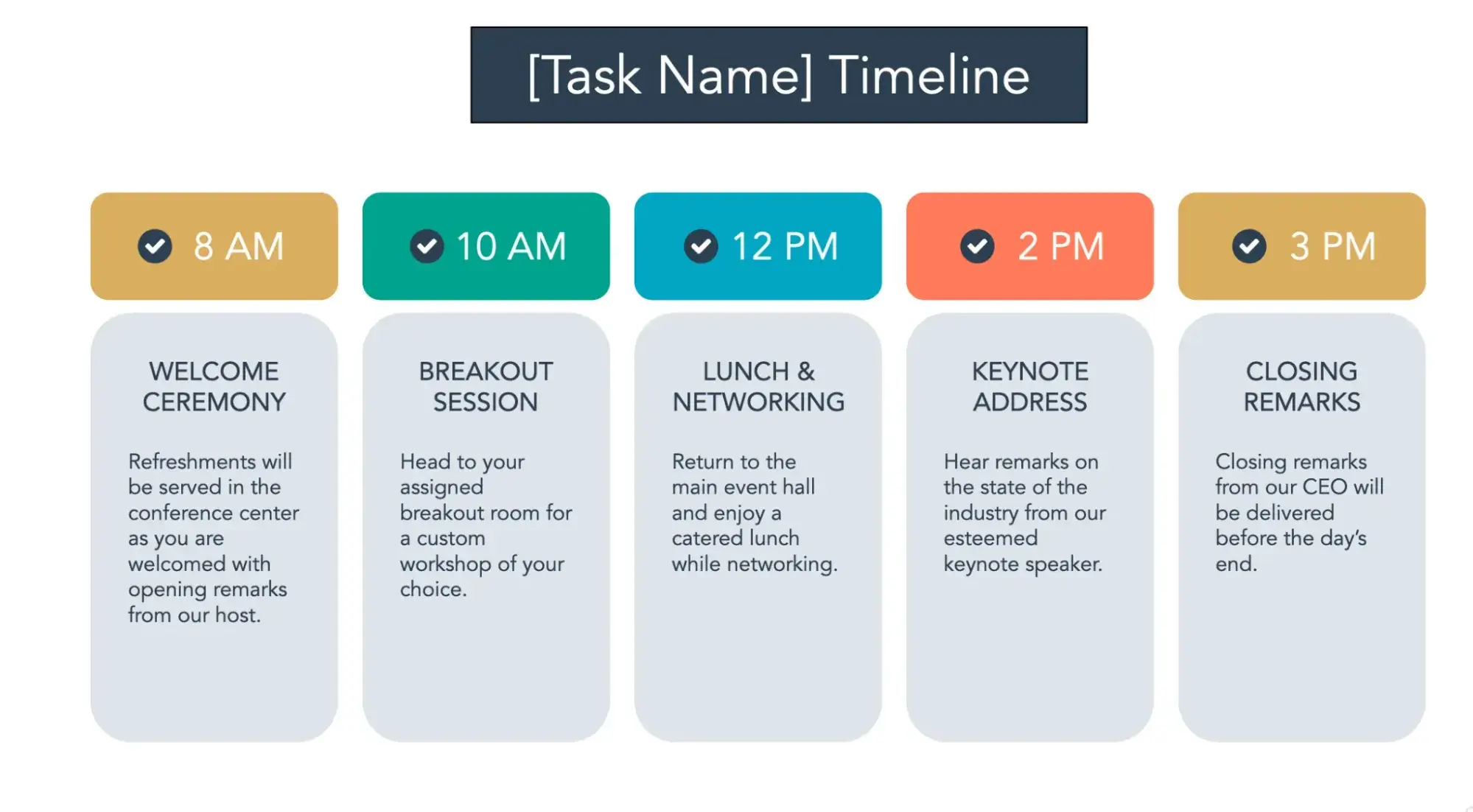
Download this Template for Free
Task timelines are great for getting people moving without having to personally direct them.
Sending these as an email attachment can save you heaps of communication time, get people where they need to be at the right time, and direct folks to what they need to be doing when it needs to be done.
Pro tip: Building an image of a timeline is great for a mental understanding of the whole period of time, and it sets expectations. To actually get people where they need to be for each step, I’ve personally found that it helps to create and share a calendar with alerts built in.
Meeting Project Timeline
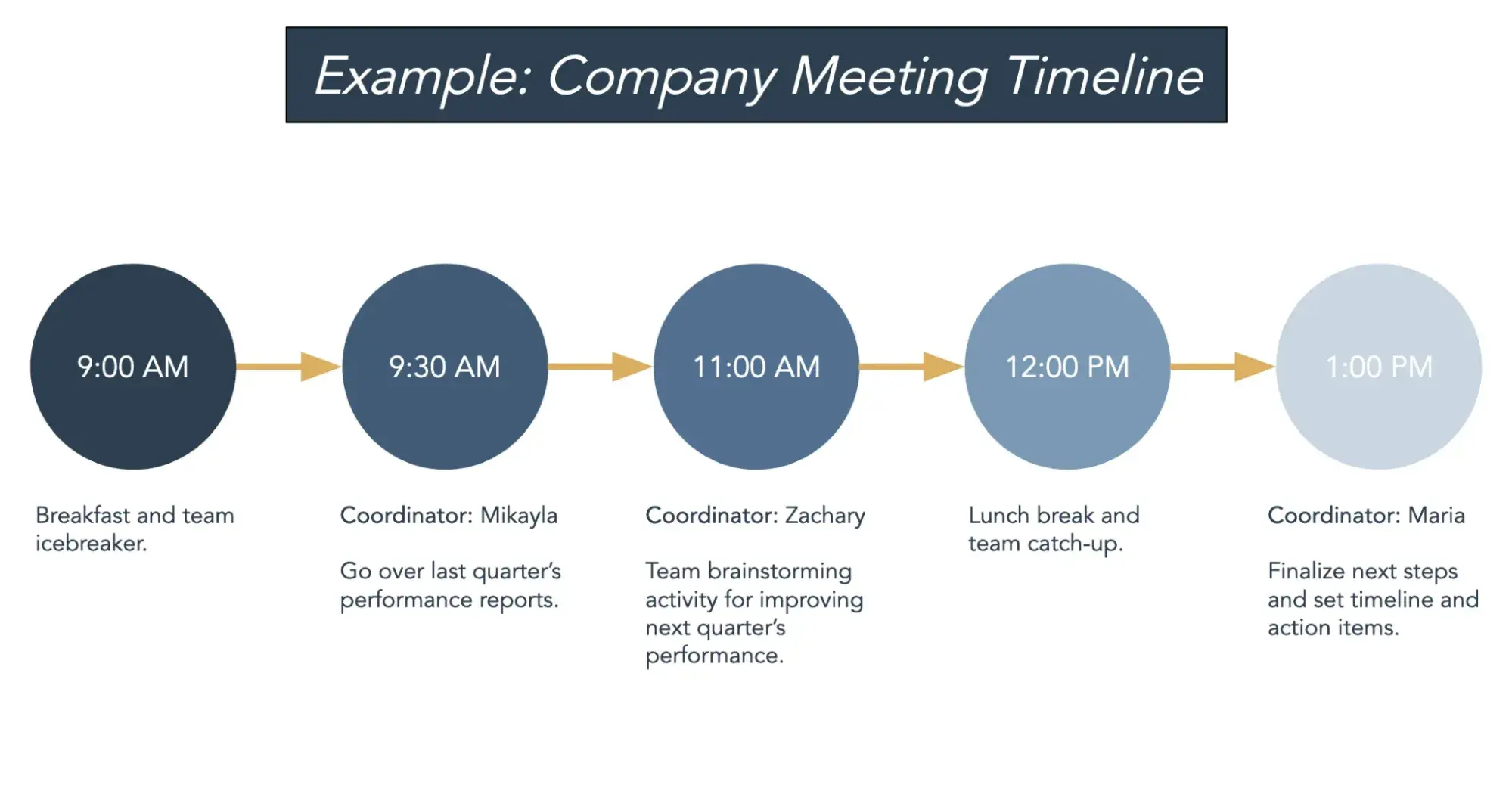
Download this Template for Free
I love a good meeting timeline. These communicate the who, what, and when your team members need to know in order to navigate the day and understand the overall purpose of the meeting block.
They can be made even more useful by providing links to the bios of the presenters, providing the talking points for each meeting in advance, and dispersing the links and passwords for any virtual meeting spaces.
What I like: As a neurospicy introvert that needs to manage my social energy, my experience has taught me that meeting timelines are particularly valuable. I want to know who I’ll be listening to, what kind of energy to expect/may be expected from me, and when to roust myself from gremlin work mode to public social mode.
Gantt Chart Example
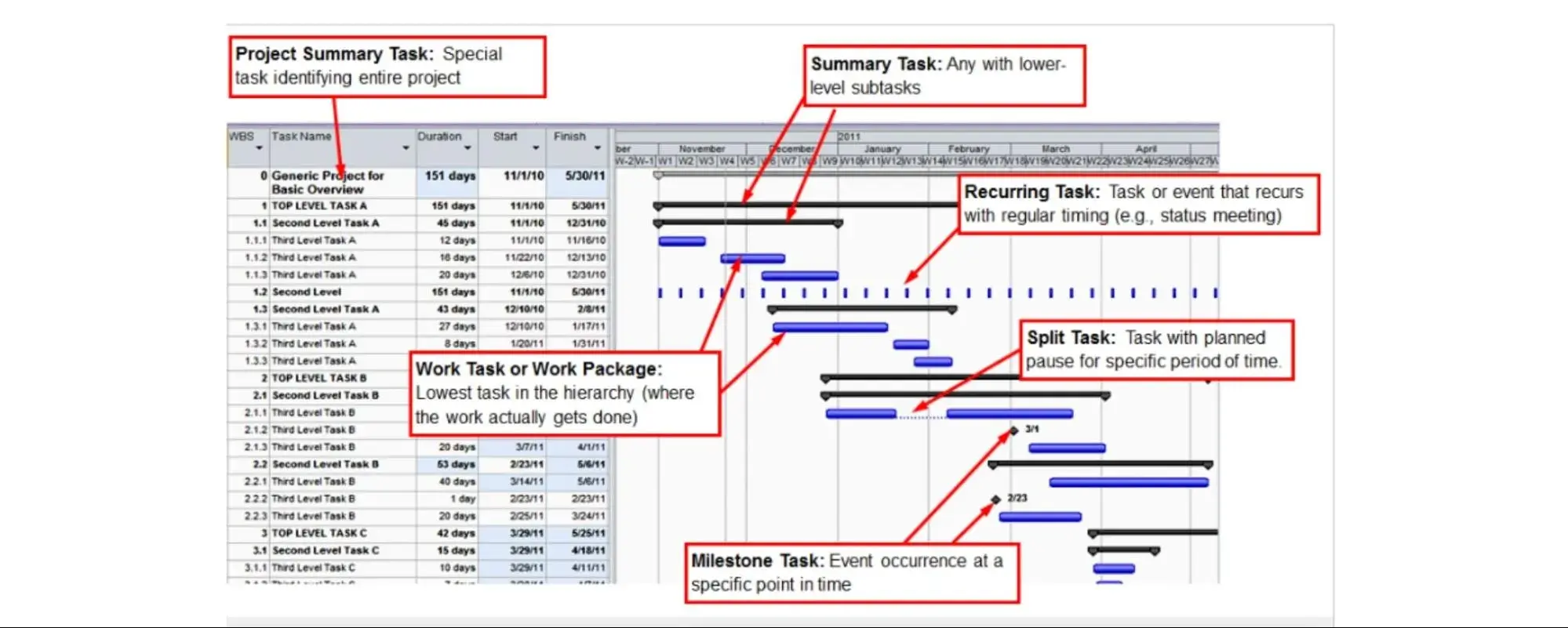
Image Source
A Gantt chart takes the timeline project examples above and hoists them to the next level. It takes all the wild threads of activity and creates a tapestry of time and tasks.
You can capture a great deal of granularity in a Gantt chart and communicate a ton of information at once.
You may need to work with your team members on how to read it and make the most of the information without being overwhelmed by it.
Best for: Project Managers who want professional-grade tools to handle large-scale projects.
Use Project Timelines to Stay on Schedule
If you’re not exactly sure what you need yet and want as many templates as you can get your hands on, download all of these project timelines (and more) for free. With the right timelines in hand, it’s easy to keep everyone up to date and informed.
Now all you have to do is make sure your projects stay on schedule. Best of luck out there, friends!
Editor’s note: This post was originally published in September 2021 and has been updated for comprehensiveness.
![]()
If Hubspot is of interest and you'd like more information, please do make contact or take a look in more detail here.
Credit: Original article published here.
